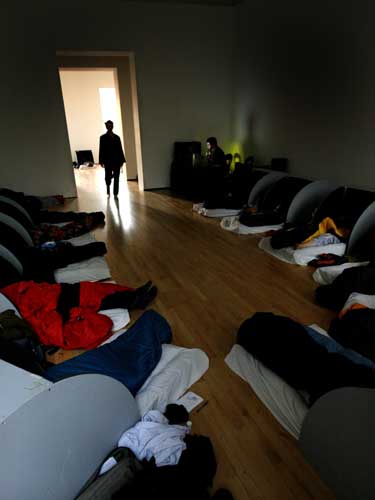The stuff of dreams
Paul Bignell furthers the cause of art and science by taking part in a unique experiment that involves sleeping with 20 strangers

What are dreams made of? This question has troubled the finest minds ever since people first woke up. Now, the ICA in London thinks it can shed some light on the matter. And, in the interests of science, I agreed to help by spending a night in an art gallery, sleeping with 20 people I had never met before.
We were part of what the ICA is calling the Dream Director, a sleepover experiment to see if our dreams could be manipulated.
Luke Jerram, an installation artist with an interest in science, created an experiment in which participants are played sounds during their sleep to see if, and how, their dreams are affected. "From my perspective I want to use it to investigate sleep space as a territory for potentially making art in dream space," said Jerram.
The experiment was quite simple: we bedded down in specially designed sleeping pods. I donned an eye mask and before long the sound of children's laughter and far off trains had lulled us to sleep.
Our masks contained infra-red sensors that detected when we fell into deep or "dreaming sleep" by measuring rapid eye movement (REM). The readings were logged in a machine called Bertha. Once we were "out", sounds are played through the speakers, each pod having its own theme of sounds. In the morning, we rolled out of bed and wrote down our dreams, our written recollections were then collected for analysis by scientists. Only afterwards were we told what sounds were played to us.
Frankly, I'd been cynical. But I have to admit, my dream was pleasant. I normally sleep fitfully, plagued by dreams about day-to-day stresses. Sleeping in the pod, my dream took me on an agreeable drive around the countryside in an open-top car, ending at a petrol station in the middle of a forest.
In the morning I found out that this was remarkably close to the sounds that played in my pod: a forest and the echoing sounds you would perhaps hear in a canyon. Maybe it was a coincidence: during the day I had been looking at a friend's pictures of Hawaii.
Fascinating, perhaps, but what use is such a thing, I asked? Well, experts believe careful analysis of dreams can change people's lives. Jennifer Parker, a dream research scientist from the University of the West of England, said the results could, for example, help people who suffer from post-traumatic stress disorder.
"One of the statistically significant findings from our studies is that people's moods in the morning were dramatically improved. For me it's the benefits of how people react in the morning and the calming influence this experiment has on them."
Join our commenting forum
Join thought-provoking conversations, follow other Independent readers and see their replies
Comments
Bookmark popover
Removed from bookmarks